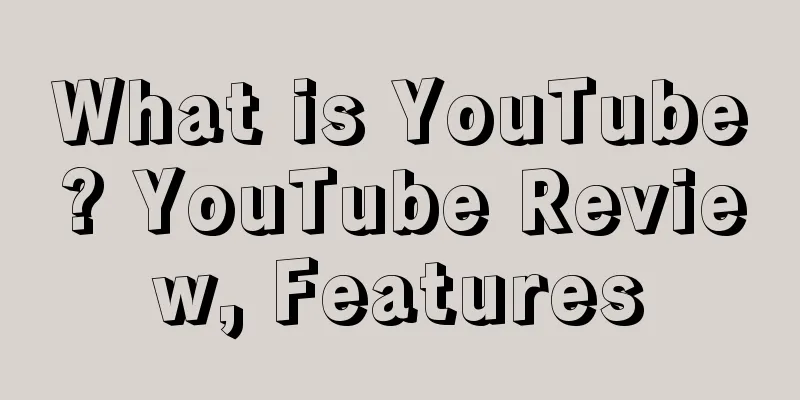What is YouTube? YouTube Review, Features

|
YouTube is the world's largest video sharing website. The company's early headquarters was in San Bruno, California, allowing users to download, watch and share videos or short films. In February 2005, it was founded by three former PayPal employees. The name and logo of the website were inspired by the cathode ray tubes used in early televisions. In November 2006, Google acquired YouTube for $1.65 billion and operated it as a subsidiary.
About YouTube In November 2006, Google acquired YouTube for $1.65 billion and operated it as a subsidiary. However, Google has always been very cautious about how to make money from YouTube. After the acquisition, YouTube is still popular among netizens around the world. Citibank analysts believe that Google may earn $2.4 billion in net income from YouTube in 2012. On January 3, 2014, YouTube announced that it would demonstrate 4K high-definition video streaming services at the Consumer Electronics Show (CES) in Las Vegas. The service uses Google's video codec technology VP9. Unregistered users of the website can still watch videos directly, while registered users can upload an unlimited number of videos. When a video contains potentially offensive content, it is only available to registered users over 18 years old. As an online video service provider in the current industry, YouTube's system processes tens of millions of video clips every day, providing high-level video upload, distribution, display, and browsing services to thousands of users around the world. In February 2015, CCTV pushed the Spring Festival Gala to overseas websites such as YouTube for the first time. The Switch app "YouTube" will be available on November 9, 2018. On December 18, 2018, the World Brand Lab published the "2018 World's Top 500 Brands", with YouTube ranking 20th.
Products and Services 1. Video playback: Users who want to watch YouTube videos need to install the ADOBE FLASH PLAYER plug-in on their personal computer web browsers. ADOBE FLASH PLAYER is a common plug-in installed on personal computers and supports nearly 75% of online videos. In January 2010, YouTube launched an experimental version of the website, which uses built-in multimedia functions to replace web browsers to meet the HTML5 standard. This means that it is not necessary to install ADOBE FLASH PLAYER or any other plug-in before watching videos. There is another page on the YouTube website that allows supported browsers to choose HTML5 mode for trial use, but only browsers that support HTML5 and use H.264 or WEBM format can play videos directly, and not all videos can be watched. 2. Video upload: YouTube has an average of 1 hour of video uploaded per second, and an average of 350,000 people upload videos every day. YouTube's video upload supports most common video file formats, including AVI, MKV, MOV, MP4, DIVX, FLV, THEORA, MPEG-4, MPEG and WMV. It also supports 3GP, allowing uploaders to upload videos using mobile phones. At the same time, YouTube has also updated the upload interface, which allows uploading multiple videos at a time, and all upload functions have been optimized. 3. Movie Channel: YouTube's movie channel has been online for a long time. Most of the content in it requires payment, starting from $1.99. Users purchase 48 hours of viewing rights, and some movies are free to watch. On July 21, 2009, YouTube software engineer Peter Bradshaw announced that YouTube users can upload 3D movies and watch them. 4. Paid channels: On May 10, 2013, YouTube launched a paid channel subscription project. In February 2013, the project's staff claimed that the platform would include at least 50 YouTube channels, and that subscribing to a single channel would cost at least $1.99 per month. In February 2013, YouTube officials told American technology media CNET that they were indeed developing such a service, but did not specify when it would be officially launched. 5. Translation function: In August 2008, YouTube added the video subtitle function, which allows users to add subtitles in multiple languages to their videos. However, for the global users of YouTube, simply adding subtitles by the uploader cannot meet the needs of multilingual users. Move the mouse to the lower right corner of the video and select the translation function in the "CC" (subtitle) icon to call the GOOGLE translation engine to translate the original subtitles in real time. 6. Live Video: On April 11, 2011, YouTube announced that YouTube LIVE, the live video platform released one year ago, has begun to launch a new pay-per-view feature, but it is not available in all markets. YouTube LIVE was released in 2012 as a free, ad-based business. YouTube has been considering how to make the YouTube LIVE platform more than just a free, ad-based service, and the company is pursuing this plan. After providing testing services to a small number of video publishers, YouTube is providing pay-per-view functionality to video publishers on the YouTube LIVE platform. YouTube said that the company is in the process of providing live video functionality to its partners. 7. TESTTUBE: Click the "Try new features!" button at the bottom of any YouTube page to enter TESTTUBE. TESTTUBE is where YouTube tests new features. It is based on the principle of user voluntariness. Users can try out several new features that have not been officially released, and then give feedback on their usage and suggestions to YouTube to help debug their new features. New features will be officially released online when user feedback is good. 8. Digital Music: One of the interesting trends in the digital music field is that YouTube is considered to be the most popular means of experiencing online music. YouTube provides users with a list of 100 hits, which is a list of 100 hits. It is updated once a week and is ranked by weekly hits by default, so generally speaking, there is little change from week to week. This list is mainly to recommend songs to users. Of course, users can also choose to rank their own 100 hits by most favorites, most comments, most popular, etc. 9. Reward function: YouTube has officially launched the function of allowing viewers to reward video uploaders in four countries, including the United States, Australia, Japan and Mexico. Users can see this option on the management page of their account and decide whether to enable this function. 10. 360-degree video: On January 7, 2015, the video website YouTube plans to support native "360-degree video" uploading and playback in the next few weeks. YouTube's support for "360-degree video" means that when users watch "360-degree video" on YouTube, they can use the mouse, buttons, etc. to adjust the camera angle without pausing the video playback. Children's version of the application: On February 21, 2015, YouTube will release a new application for children, YouTube Kids, which will include smartphone and tablet versions and focus on content suitable for children. Starting from February 23, 2015, users will be able to download this free application, which will also adopt a child-friendly design with larger icons. YouTube Kids will be distinguished from YouTube's own application. This application will support parental control functions such as timers, making it easier for parents to control the time children use the device.
Development History -In February 2005, YouTube was founded by three former PAYPAL employees: Chad Hurley, Steve Chen, and Jawed Karim. -In April 2005, the first video on YouTube was uploaded by Karim and was only 19 seconds long. -In 2006, YouTube had 40 million short videos and attracted 6 million visitors every day. In just 15 months after its establishment, it surpassed competitors such as MSN VIDEO and GOOGLE VIDEO to become the most visited website in this century. -In November 2006, Google acquired YouTube for $1.65 billion. -In June 2007, YouTube announced in Paris that it would begin expanding its global localization services, with the first wave launching versions in nine languages. -In October 2007, Chinese websites were opened in Hong Kong and Taiwan. -In August 2008, according to the IT blog "Dancing with G", Google's video website YouTube officially supports simplified Chinese, which is a key step for Google to enter the Chinese market in a roundabout way. -In November 2008, YouTube reached an agreement with MGM, Lionsgate Entertainment and CBS to allow full-length movies and TV series to be broadcast on its US website. -In November 2009, YouTube signed another contract with Channel 4 in the UK. Channel 4 will upload all of its programs to YouTube's TV section "SHOW", allowing UK YouTube users to watch Channel 4's programs for free and in their entirety. In total, more than 4,000 complete TV series have been uploaded with more than 60 partner companies. Channel 4 has become the world's first mass media to provide complete programs for YouTube. -In January 2010, YouTube began providing movie rental services to American users. -On July 17, 2015, Google released its second quarter financial report for the 2015 fiscal year ending June 30, showing that YouTube now has more than 1 billion users, and almost one-third of all Internet users in the world spend a total of hundreds of millions of hours watching videos on YouTube every day. YouTube's viewing time is now up 60% year-on-year, the highest growth rate in several years. In 2016, YouTube’s first batch of original programming debuted on its premium service, starting with series from some of the platform’s most popular video creators. -In June 2017, the "BrandZ Top 100 Most Valuable Global Brands 2017" was announced, with YouTube ranked 65th. -In July 2018, the company's YouTube was developing scripted series and other original programming for international markets such as France, Germany, Japan, Mexico and India, which appear in a variety of formats, including music documentaries, reality shows, talk shows and scripted series. -On December 18, 2018, the "2018 World's Top 500 Brands" compiled by the World Brand Lab was announced, and YouTube ranked 20th. |
<<: What is API? API Review, Features
>>: What is Subscribe and save? Subscribe and save Review, Features
Recommend
What is North Russia International? North Russia International Review, Features
Beiruo International is an e-commerce development...
Counting COVID-19 patients by hand? Japan's operation shocked everyone
According to foreign media reports, on the 17th ,...
What is Prosperna? Prosperna Review, Features
Founded in 2018, Prosperna is 110% focused on hel...
What is Samurai Seller? Samurai Seller Review, Features
<span data-docs-delta="[[20,{"gallery"...
iOS privacy policy changes cost social media companies nearly $10 billion
Social media platforms including Facebook, Snapch...
What is Faxin Notary Cloud (Xiamen) Technology Co., Ltd.? Faxin Notary Cloud (Xiamen) Technology Co., Ltd. Review, Features
The online notarization platform of Faxin Notariz...
Sellers, get it now! DHL proposes four e-commerce supply chain trends for 2021
DHL, a subsidiary of global logistics company Deu...
Many popular products were exposed for safety risks, and 149 listings were deleted
Recently, consumer watchdog Which? warned British...
46% of retailers added Halloween collections this year
New research commissioned by Perfetti Van Melle, ...
What is MakeShop? MakeShop Review, Features
Makeshop is an e-commerce platform in Japan that ...
Early childhood education animation peripherals are hot-selling! YouTube views exceed 110 billion
When it comes to the topic of early childhood edu...
What is Eecpay? Eecpay Review, Features
<span data-docs-delta="[[20,{"gallery"...
Temu's monthly active users in Korea approach 7 million
The presence of Chinese e-commerce platforms in S...
What is Green International? Green International Review, Features
Green International is a technology-based interna...
The top 100 European cross-border e-commerce platforms are released, and Amazon is not the first!
According to a survey report by Cross-Border Comm...









